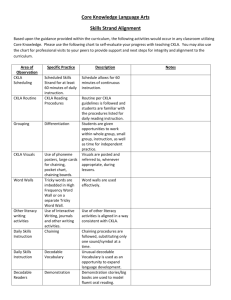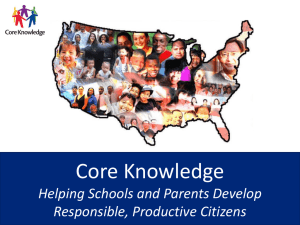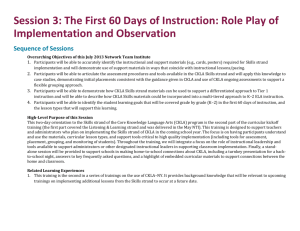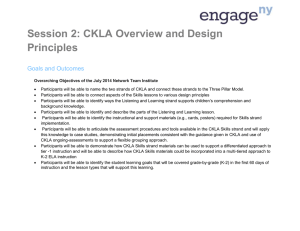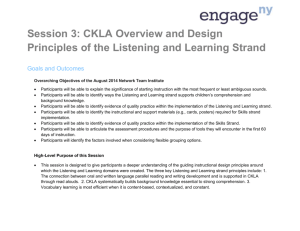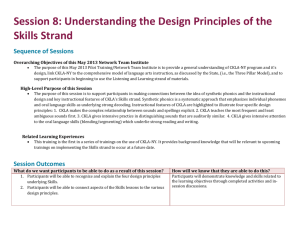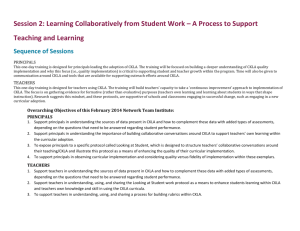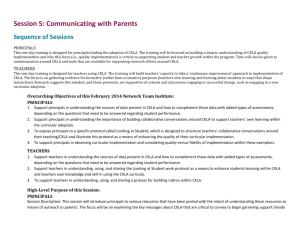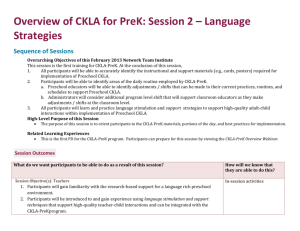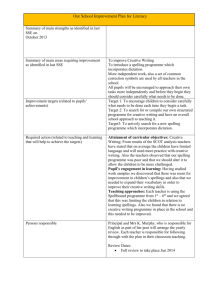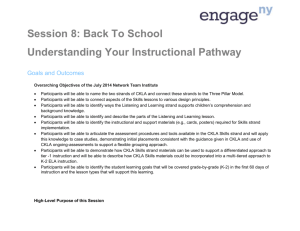Session 7, Tools for Working with Parents in the CKLA
advertisement
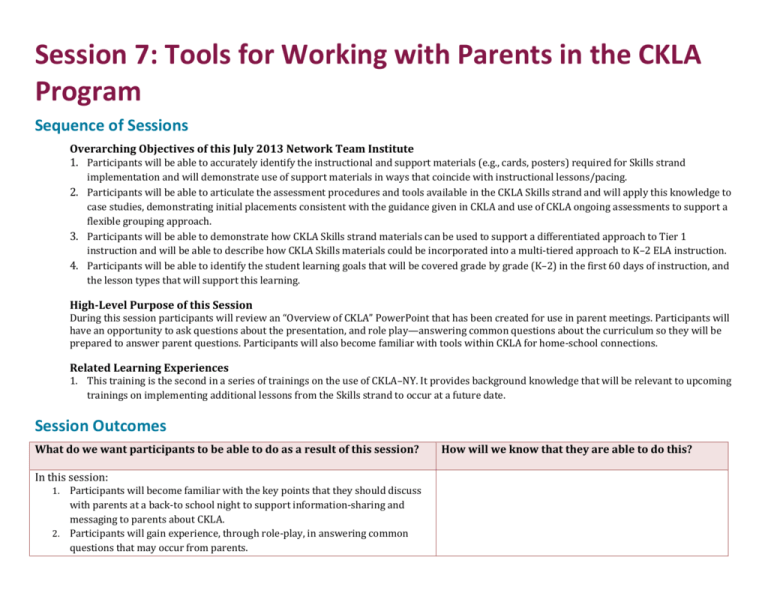
Session 7: Tools for Working with Parents in the CKLA Program Sequence of Sessions Overarching Objectives of this July 2013 Network Team Institute 1. Participants will be able to accurately identify the instructional and support materials (e.g., cards, posters) required for Skills strand implementation and will demonstrate use of support materials in ways that coincide with instructional lessons/pacing. 2. Participants will be able to articulate the assessment procedures and tools available in the CKLA Skills strand and will apply this knowledge to case studies, demonstrating initial placements consistent with the guidance given in CKLA and use of CKLA ongoing assessments to support a flexible grouping approach. 3. Participants will be able to demonstrate how CKLA Skills strand materials can be used to support a differentiated approach to Tier 1 instruction and will be able to describe how CKLA Skills materials could be incorporated into a multi-tiered approach to K–2 ELA instruction. 4. Participants will be able to identify the student learning goals that will be covered grade by grade (K–2) in the first 60 days of instruction, and the lesson types that will support this learning. High-Level Purpose of this Session During this session participants will review an “Overview of CKLA” PowerPoint that has been created for use in parent meetings. Participants will have an opportunity to ask questions about the presentation, and role play—answering common questions about the curriculum so they will be prepared to answer parent questions. Participants will also become familiar with tools within CKLA for home-school connections. Related Learning Experiences 1. This training is the second in a series of trainings on the use of CKLA–NY. It provides background knowledge that will be relevant to upcoming trainings on implementing additional lessons from the Skills strand to occur at a future date. Session Outcomes What do we want participants to be able to do as a result of this session? In this session: Participants will become familiar with the key points that they should discuss with parents at a back-to school night to support information-sharing and messaging to parents about CKLA. 2. Participants will gain experience, through role-play, in answering common questions that may occur from parents. 1. How will we know that they are able to do this? 3. Participants will become familiar with the tools within CKLA for home-school connection, including parent letters and take-home materials. Session Overview Section Time Section 1: Supporting Parent Understanding of CKLA 30 Minutes Overview Prepared Resources Facilitator Preparation Handouts for Parents” 1. Basic Code Lesson Checklist (studentcodesheets.pdf) 2. Sample L&L Parent Letter (SampleL&LLetter.pdf) 3. Sample Skills Parent Letter (SampleSkillsLetter.pdf) For presenter reference: 4. ParentFAQ (ParentFAQ.pdf) Session Roadmap Section 1: Supporting Parent Understanding of CKLA Time: 30 minutes [30 minutes] In this section, you will… 1. Become familiar with the key points that they should discuss with parents at a back-to-school night to support information-sharing and messaging to parents about CKLA. 2. Gain experience, through role play, in answering common questions that may occur from parents. 3. Become familiar with the tools within CKLA for home-school connection, including parent letters and take-home materials. Materials used include: 1. NTI_July2013_Session7_WorkingWithParents_PPT 2. NTI_July2013_Session7_WorkingWithParents_Materials.zip Time Handouts: 1. Basic Code Lesson Checklist (studentcodesheets.pdf) 2. Sample L&L Parent Letter (SampleL&LLetter.pdf) 3. Sample Skills Parent Letter (SampleSkillsLetter.pdf) 4. ParentFAQ (ParentFAQ.pdf) Slide #/ Pic of Slide Script/ Activity directions: (Please Note: Here we provide key ideas per slide. A full script is provided within the power point slides in the “Notes” view). GROUP Slide 4 NOTE: This instructor guide and the slides documented below are intended to be used with an audience of parents. Through review of this presentation and a debriefing activity, NTI/Pilot participants will meet the objectives above. Key Points: 1. Reading is more than just sounding out words. 2. In addition to sounding out, or “decoding” the reader has to comprehend the language of the text. 3. Thus reading is comprised of both “decoding” skills and language “comprehension. Slide 5 Key Points: 1. CKLA is comprised of two strands to address these two “keys” of reading. 2. The Skills strand addresses the first key, decoding. 3. The Listening & Learning strand addresses the second key, language comprehension. Slide 6 Key Point: 1. The Skills strand addresses: a. Phonics b. Grammar c. Spelling d. Handwriting e. The writing process f. And of course, reading Slide 7 Key Point: 1. The Listening & Learning Strand uses read-alouds, paired with discussion, vocabulary work, and extension activities to build children’s knowledge and language skills. Slide 8 Key Point: 1. Let’s take a closer look at the skills strand. Slide 9 Key Point: 1. Can you guess the significance of the number 270 with regard to reading instruction? Slide 10 Key Points: 1. There are 270+ pieces of “code” that make up written English language. 2. These include various letters, sounds, spellings, and rules of directionality and grammar. Slide 11 Key Points: Key aspects of the skills strand are: 1. A focus on sounds, or phonemes. 2. That it teaches the most common or least ambiguous spellings first. 3. That reading and writing taught in tandem. 4. That students read and write only what they have been taught. 5. That there are 100% decodable readers. 6. That the program is explicit, leaving nothing out to leave no one behind. Slide 12 Key Points: 1. The relationships between sounds and spellings in the English language are complex. 2. There are not one-to-one correspondences between spellings and sounds. 3. Some sounds have more than one spelling – consider wait and state. 4. Some spellings make more than one sound – consider cough and through. Slide 13 Key Pints: 1. CKLA teaches the “basic code” in Kindergarten. 2. This is the most frequent or least ambiguous spelling for each sound. 3. Teaching the most frequent spelling for sounds allows children to read more words faster – they will encounter these spelling more often in reading. 4. Focusing on the least ambiguous spelling avoids confusion for the youngest readers until they gain more experience. 5. Pass out copy of student code charts for parents. Slide 14 Key Points: 1. Every relationship (between a sound and spelling) is made to be explicit and is introduced gradually to help children achieve mastery in some spelling patterns before others are introduced explicitly. 2. The sound becomes the anchor of instruction and this is what is meant by a ‘sound-first’ approach. 3. The instructional language when discussing sounds and spellings is very precise and helps children keep the idea of sounds and spellings as distinct but related things. 4. At this point Instructor may wish to engage parents in some opportunities to practice in a way that mimics CKLA skills instruction. Perhaps, • Pronouncing sounds with a hand mirror • Oral blending and segmenting, • Chaining • Or walk parents through one sound lesson, demonstrating where it occurs in the workbook practice and readers as well. Slide 15 Key Point: 1. Participants consider the way that the least ambiguous, most frequent spelling pattern creates many words children can read and minimizes confusion by examining the readers. Slide 16 Key Points: 1. Students will read a variety of texts that represent increasing complexity, rich content, diverse characters, and continuing story lines. Slide 17 Key Points: 1. Because we know what spellings have been taught, the readers focus on those spellings. 2. Children get many opportunities to practice reading words without the distraction of spellings that have not yet been taught. 3. This helps to build the automaticity that is required for reliable, fluent reading. Slide 18 Key Points: 1. Copies of stories will accompany a parent letter from each unit. 2. In the classroom, we focus on these stories, but your child should engage in a volume of reading outside of the classroom when possible. 3. Help your child choose books that are challenging, but not too difficult for him or her to read. Note: You may wish to add more guidelines here for parents regarding book selection and independent reading. Slide 19 Key Points: 1. Spelling patterns are taught as each sound is addressed in the program. 2. The program also includes grammar and handwriting lessons. Slide 20 Key Point: 1. CKLA includes writing across a variety of genres using a 3-stage process of planning, drafting, and editing. Slide 21 Key Point: 1. Let’s take a closer look at the Listening & Learning strand. Slide 22 Key Points: 1. Children’s listening comprehension outpaces their reading comprehension until about age 13. 2. This makes read-alouds a great vehicle for teaching students many things. Slide 23 Key Points: 1. CKLA read-alouds include topics that build knowledge both within grades and across grades. 2. The arrows represent connections that demonstrate a building of knowledge. 3. Can you identify any other possible connections in these topics? Slide 24 Key Points: 1. The topics in CKLA build coherently. 2. King Ferdinand and Queen Isabella sent Columbus on his voyage so Kings and Queens are taught before Columbus. 3. Columbus encountered Native Americans, so Native Americans are taught before Columbus. 4. Native Americans hunted and farmed, so farming is taught before Native Americans; likewise, plants are taught before farms and so on… Slide 25 Key Points: 1. Rich topics bring with them rich language and vocabulary. 2. Staying on topic allows time for students to learn the language associated with the topic and engrain the relationships between the words associated with the topic. Slide 26 Key Points: 1. The Listening & Learning strand includes both fiction and nonfiction reading. 2. The stories are read aloud, but students do not see the words. 3. In this way, the demands of sounding out the words on the page are removed so students can focus on listening and comprehension. 4. Images for the stories are displayed or projected. Slide 27 Key Points: 1. Each lesson includes a read-aloud, structured as follows: a. A 10 minute introduction b. A 10-15 minute read aloud on the domain topic c. A 15 minute discussion that incudes comprehension questions and a little bit of explicit vocabulary instruction. While most vocabulary is learned implicitly – through exposure, explicit vocabulary instruction will especially help ELLs 2. Each unit also includes a related extension activity giving students the opportunity to use newly learned concepts and language. 3. Instructor may wish to do a model Listening & Learning reading at this point. Slide 28 Key Point: 1. You can prepare to support learning at home: a. Create a special area that supports learning. b. Include tools to support learning (paper, pencils, markers, etc.). c. Consider educational gifts that support learning. Slide 29 Key Point: 1. You can reinforce the learning that takes place in the CKLA program in the following ways: a. Follow guidance in take home letters. b. Have your child read to you. c. Complete practice activities sent home by teacher. d. Attend field trips and events centered around the people and places in the stories. e. Read to your child from the domain trade book list. f. Read to your child from What Your—Grader Needs to Know. These books cover the same topics as CKLA Listening & Learning. Debrief with NTI/Pilot participants: Review the Parent FAQ document. Using the provided protocol, create answers to the following 3 “parent” questions based on knowledge gained in sessions 1 through 6: 1. What if I feel my child is performing above grade level? 2. How will my child’s progress be assessed? 3. How can I help my child at home? Use the following icons in the script to indicate different learning modes. Video Reflect on a prompt Active learning Turnkey Materials Provided See handouts for lesson type checklists (blank for use during activity; completed to be reflected on after the activity). Additional Suggested Resources Turn and talk
